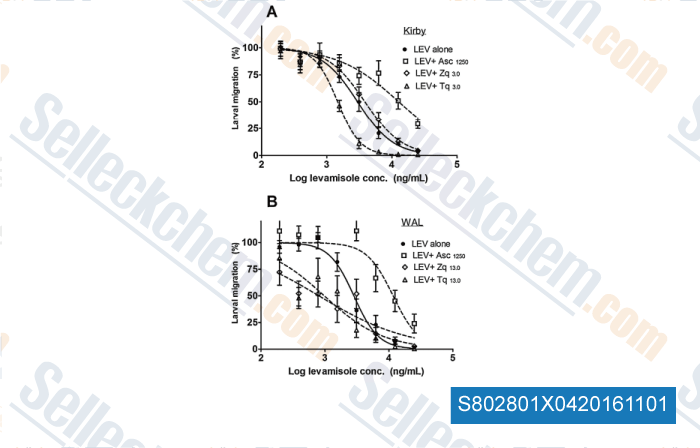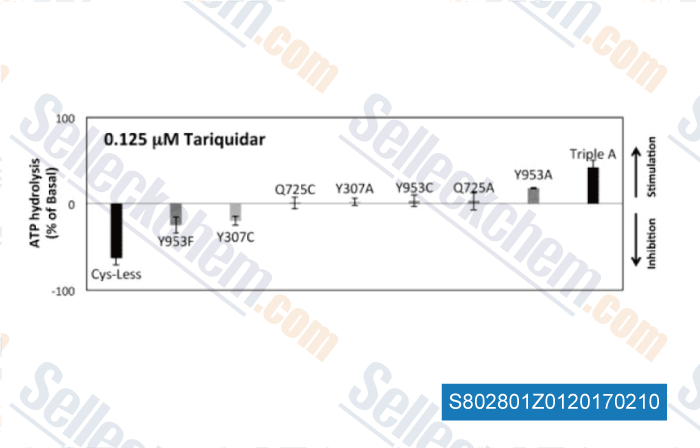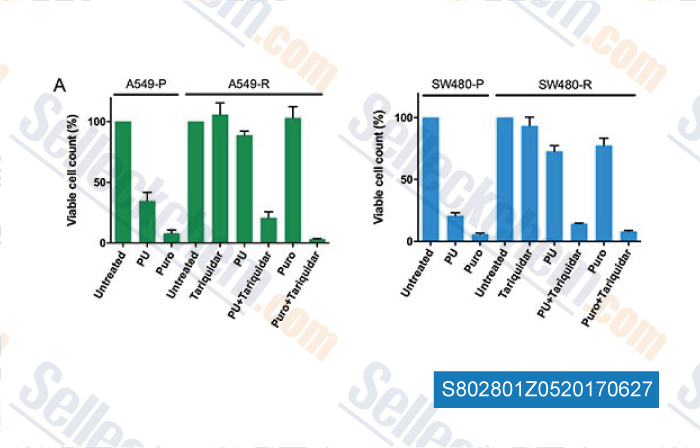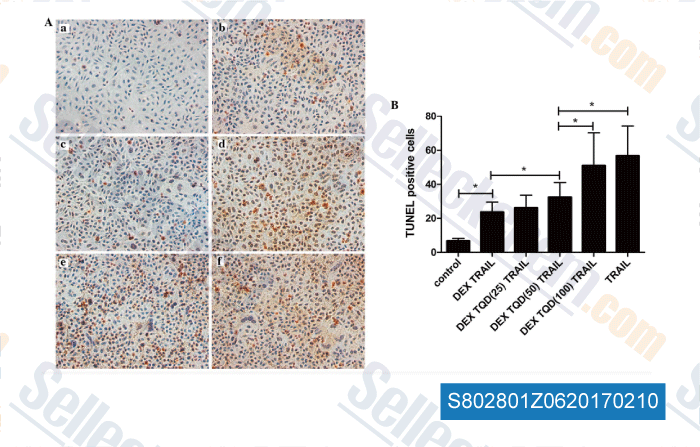|
Toll Free: (877) 796-6397 -- USA and Canada only -- |
Fax: +1-832-582-8590 Orders: +1-832-582-8158 |
Tech Support: +1-832-582-8158 Ext:3 Please provide your Order Number in the email. |
Technical Data
| Formula | C38H38N4O6 |
|||
| Molecular Weight | 646.73 | CAS No. | 206873-63-4 | |
| Solubility (25°C)* | In vitro | DMSO | 8 mg/mL (12.36 mM) | |
| Water | Insoluble | |||
| Ethanol | Insoluble | |||
|
* <1 mg/ml means slightly soluble or insoluble. * Please note that Selleck tests the solubility of all compounds in-house, and the actual solubility may differ slightly from published values. This is normal and is due to slight batch-to-batch variations. * Room temperature shipping (Stability testing shows this product can be shipped without any cooling measures.) |
||||
Preparing Stock Solutions
Biological Activity
| Description | Tariquidar is a potent and selective noncompetitive inhibitor of P-glycoprotein with Kd of 5.1 nM in CHrB30 cell line, reverses drug resistance in MDR cell Lines. Phase 3. | ||
|---|---|---|---|
| Targets |
|
||
| In vitro | Tariquidar displays high-affinity binding to P-gp with Bmax of 275 pmol/mg. Tariquidar shows non-competitive interaction with the P-gp substrates vinblastine and paclitaxel. Tariquidar increases the steady-state accumulation of these cytotoxics in CHrB30 cells to levels observed in non-P-gp-expressing AuxB1 cells with EC50 of 487 nM. Tariquidar is able to inhibit the vanadate-sensitive ATPase activity of P-gp by 60-70%, with potent IC50 values of 43 nM. [1] Tariquidar may inhibit other resistance mechanisms at higher concentrations. 1 μM Tariquidar abrogates ABCG2 (BCRP)-mediated resistance to camptothecins in vitro. [2] Tariquidar potentiates the cyto-toxicity of several drugs including doxorubicin, paclitaxel, etoposide, and vincristine; complete reversal of resistance is achieved in the presence of 25- 80 nM Tariquidar. In MC26, a murine colon carcinoma cell line with intrinsic chemoresistance, the doxorubicin IC50 is fivefold lower in the presence of 0.1 μM Tariquidar (36 vs 7 nM). In murine mammary carcinoma, human small-cell lung carcinoma and human ovarian carcinoma cell lines with acquired chemotherapeutic resistance (EMT6/AR1.0, H69/LX4 and 2780 AD), the in vitro doxorubicin IC50 is 22-150-fold lower in the presence of 0.1 μM Tariquidar. P-gp inhibition persists for 23 h after removal of Tariquidar from the culture system. [3] Tariquidar restored the cyto-toxicity of doxorubicin and vinblastine in the National Cancer Institute (NCI)/ADRRES multicellular tumor spheroid model derived from the MCF7WT breast cancer cell line. [4] | ||
| In vivo | Tariquidar (2- 8 mg/kg p.o.) is found to significantly potentiate the antitumor activity of doxorubicin (5 mg/kg, i.v.) against MC26 murine colon carcinoma in vivo. In human carcinoma xenografts, coadministration of XR9576 (6 -12 mg/kg p.o.) fully restored the antitumor activity of paclitaxel, etoposide, and vincristine against two highly resistant MDR human tumor xenografts (2780AD, H69/LX4) in nude mice. [3] |
Protocol (from reference)
| Kinase Assay: |
|
|---|---|
| Cell Assay: |
|
| Animal Study: |
|
References
Customer Product Validation

-
, , Vet Parasitol, 2015, 211(1-2):80-8.

-
Data from [Data independently produced by , , Biochem Pharmacol, 2016, 101:40-53.]

-
Data from [Data independently produced by , , Oncotarget, 2017, 8(5):7678-7690]

-
Data from [Data independently produced by , , Mol Med Rep, 2015, 12(6):8093-100.]
Selleck's Tariquidar has been cited by 50 publications
| Tumor-acquired somatic mutation affects conformation to abolish ABCG2-mediated drug resistance [ Drug Resist Updat, 2024, 73:101066] | PubMed: 38387283 |
| Zosuquidar: An Effective Molecule for Intracellular Ca2+ Measurement in P-gp Positive Cells [ Int J Mol Sci, 2024, 25(6)3107] | PubMed: 38542082 |
| The net electrostatic potential and hydration of ABCG2 affect substrate transport [ Nat Commun, 2023, 14(1):5035] | PubMed: 37596258 |
| The net electrostatic potential and hydration of ABCG2 affect substrate transport [ Nat Commun, 2023, 14(1):5035] | PubMed: 37596258 |
| MDR1 Inhibition Reverses Doxorubicin-Resistance in Six Doxorubicin-Resistant Canine Prostate and Bladder Cancer Cell Lines [ Int J Mol Sci, 2023, 24(9)8136] | PubMed: 37175843 |
| MDR1 Inhibition Reverses Doxorubicin-Resistance in Six Doxorubicin-Resistant Canine Prostate and Bladder Cancer Cell Lines [ Int J Mol Sci, 2023, 24(9)8136] | PubMed: 37175843 |
| Establishment and Characterization of Multi-Drug Resistant p53-Negative Osteosarcoma SaOS-2 Subline [ Diagnostics -Basel), 2023, 13(16)2646] | PubMed: 37627905 |
| Establishment and Characterization of Multi-Drug Resistant p53-Negative Osteosarcoma SaOS-2 Subline [ Diagnostics (Basel), 2023, 13(16)2646] | PubMed: 37627905 |
| Panax notoginseng saponins reverse steroid resistance in lupus nephritis: Involvement of the suppression of exosomal P-gp levels from lymphocytes to glomerular endothelial cells [ Biochem Biophys Rep, 2023, 36:101568] | PubMed: 38024866 |
| Functional Blood-Brain Barrier Model with Tight Connected Minitissue by Liquid Substrates Culture [ Adv Healthc Mater, 2022, e2201984] | PubMed: 36394091 |
RETURN POLICY
Selleck Chemical’s Unconditional Return Policy ensures a smooth online shopping experience for our customers. If you are in any way unsatisfied with your purchase, you may return any item(s) within 7 days of receiving it. In the event of product quality issues, either protocol related or product related problems, you may return any item(s) within 365 days from the original purchase date. Please follow the instructions below when returning products.
SHIPPING AND STORAGE
Selleck products are transported at room temperature. If you receive the product at room temperature, please rest assured, the Selleck Quality Inspection Department has conducted experiments to verify that the normal temperature placement of one month will not affect the biological activity of powder products. After collecting, please store the product according to the requirements described in the datasheet. Most Selleck products are stable under the recommended conditions.
NOT FOR HUMAN, VETERINARY DIAGNOSTIC OR THERAPEUTIC USE.
